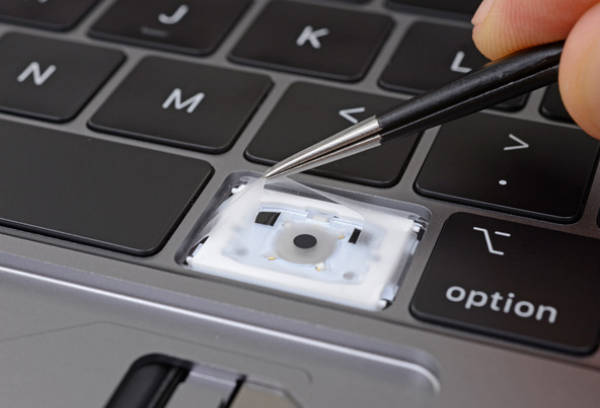The brand new 2018 Apple MacBook Pro boasts a quieter keyboard than earlier models — and what’s touted as a new feature actually may be a fix for an old problem.
But if that’s the case, Apple’s not telling.
Reporting on a dramatic discovery found in the middle of its 2018 MacBook Pro teardown, IFixIt called out a new bit of noise-reduction tech: “Apple has cocooned their butterfly switches in a thin, silicone barrier….. the advertised boost in quietude is a side-effect of this rubbery membrane. The quiet angle is, quite literally, a cover-up.”
The MacBook Pro’s nagging problem since 2016 has been keyboard failure due to dust and crumbs getting under the butterfly key switches. Apple began using butterfly switches instead of scissors-style key switches in the 2016 model year to reduce the laptop’s thickness.
More on the MacBook Pro keyboard issue
- Failure rate is double that of older models
- Apple patented the keyboard as “crumb-resistant”
- MacBook Pro owners filed a class-action lawsuit
- DIY keyboard repairs — worth it?
- The problem isn’t going away on the 2018 MacBook Pro
Keyboard failure and reliability issues have plagued the flagship laptop since 2016. The saga has included doubled failure rates, denials, lawsuits, and dramatically upgraded factory repair and replacement policies for keyboards taken down by dust and crumbs.
The story took a different turn earlier this year when Apple appeared to be working on a solution to a problem no one complained about, or at least not as much as keyboard death-by-dust-and-crumbs.
In March Apple filed a patent application for a keyboard that company engineers wrote was designed to block “liquid ingress around the keys into the keyboard.”
Liquid spills were not a significantly greater problem with the butterfly switch keyboards, however. Pointedly, the boosted repair policy that covers dust and crumb-damaged keyboards does not extend to keyboards damaged by liquid.
The Verge asked about the new keyboard during the press rollout event for the 2018 MacBook Pro. Apple representatives insisted the change wasn’t designed to solve reliability issues, but only to reduce keyboard noise. When asked how the keyboard design was changed to make it less noisy, the Apple reps would not answer.




